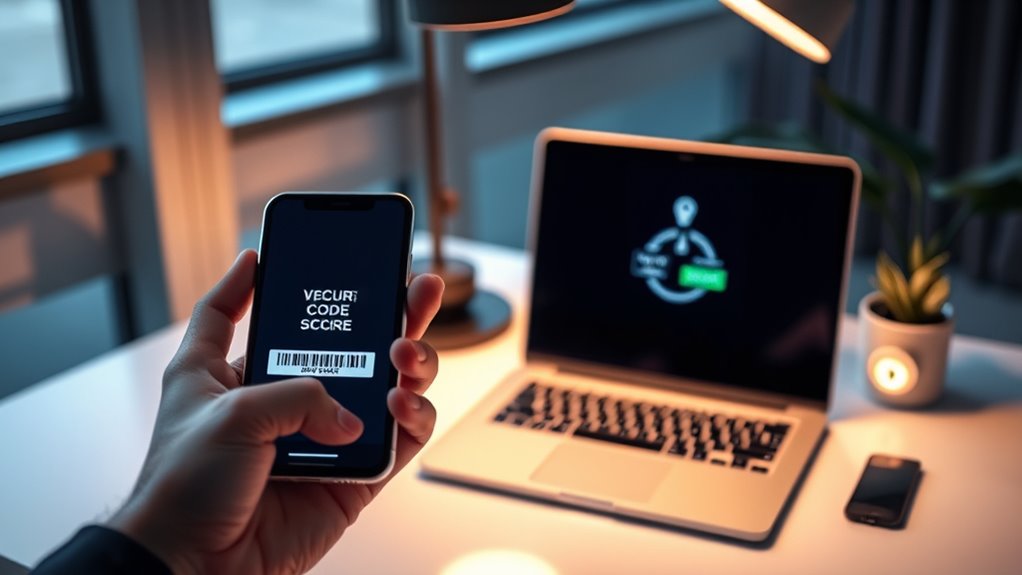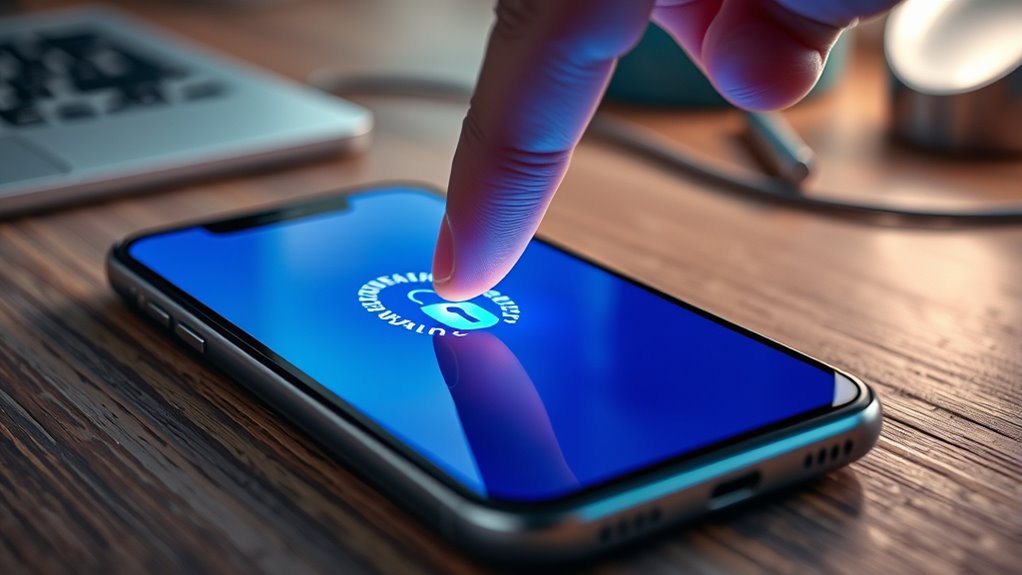Two-factor authentication (2FA) adds an extra layer of security to your accounts by requiring two different verification methods before access is granted. Usually, you provide something you know (like a password) and something you have (such as a code from a hardware token or biometric data). This makes it much harder for hackers to break in, even if they steal your password. To understand how these methods work together to protect your digital security, keep exploring the details.
Key Takeaways
- 2FA adds an extra security layer by requiring two verification methods beyond just a password.
- Common 2FA methods include biometric verification and hardware tokens, enhancing account protection.
- Biometric verification uses unique physical traits like fingerprints or facial recognition for quick access.
- Hardware tokens generate one-time codes, providing a physical barrier against phishing and cyber threats.
- Implementing 2FA significantly reduces unauthorized access risk and strengthens overall digital security.

Have you ever wondered how to better protect your online accounts? Two-factor authentication (2FA) is a powerful way to do just that. Instead of relying solely on a password, 2FA requires you to provide two different types of verification to access your account. This extra layer of security makes it considerably harder for hackers to gain unauthorized access, even if they’ve stolen your password.
One common method of 2FA involves biometric verification. This means you use a unique physical trait—like your fingerprint, facial recognition, or even your voice—to confirm your identity. Biometric verification is convenient because it leverages something you inherently possess, making it faster and easier to authenticate yourself. For example, many smartphones now incorporate fingerprint scanners or facial recognition, allowing you to disarm your device or access apps securely with a simple touch or glance. When integrated with 2FA, biometric verification assures that only you can verify your identity, adding a robust barrier against impersonation or hacking attempts.
Another popular method is the use of hardware tokens. These small devices generate one-time codes that you need to enter alongside your password. Hardware tokens are physically separate from your computer or phone, so even if your password is compromised, the attacker can’t access your account without the token. You might carry a key fob-sized device or use a USB stick that produces these codes. Many security-conscious organizations and services recommend or require hardware tokens because they provide a high level of security. They’re resistant to phishing because the codes are only valid for a short window and are generated locally on the device, not transmitted over the internet.
Implementing 2FA with biometric verification and hardware tokens isn’t complicated, and it’s well worth the effort. Many online platforms now support biometric login options, making it easy to set up and use. Hardware tokens, while slightly more involved to set up, offer an extra layer of security, especially for sensitive accounts like email, banking, or corporate systems. Combining these methods gives you a layered defense: biometrics provide quick, convenient access, while hardware tokens add a physical barrier that’s tough for hackers to bypass.
Additionally, integrating holistic approaches to health and wellness into your overall security mindset can help you develop a more comprehensive and proactive stance against cyber threats. In today’s digital landscape, relying only on passwords isn’t enough. Incorporating biometric verification and hardware tokens into your 2FA strategy helps guarantee that your online accounts are much more secure. It’s a smart move to protect your personal information, finances, and digital identity from increasingly sophisticated cyber threats.
Frequently Asked Questions
Can 2FA Be Bypassed by Hackers?
Yes, hackers can sometimes bypass 2FA, especially through phishing risks where they trick you into revealing codes or passwords. They may also exploit vulnerabilities in hardware token security or intercept authentication messages. To protect yourself, stay vigilant against phishing attempts, keep your hardware tokens secure, and use additional security measures. While 2FA considerably enhances security, no system is entirely foolproof, so staying cautious is essential.
Is 2FA Necessary for All Online Accounts?
You might stumble upon a thief who steals your phone while you’re shopping, highlighting why 2FA is essential. Not all online accounts support 2FA, but enabling it on compatible accounts greatly enhances security. It works across devices, ensuring synchronization and protection even if someone tries to access your info. For sensitive accounts like banking or email, 2FA isn’t just helpful — it’s a must-have for peace of mind.
How Often Should I Update My 2FA Methods?
You should update your 2FA methods regularly, ideally every 3 to 6 months. This practice supports password rotation, reducing the risk of compromised accounts, and enhances hardware token security. If you notice any suspicious activity or if your device is lost or stolen, update your 2FA immediately. Staying proactive helps protect your accounts from potential breaches, ensuring your digital security remains strong and reliable.
Are There Any Risks Associated With Sms-Based 2FA?
Yes, SMS-based 2FA has risks, mainly due to SMS vulnerabilities like SIM swapping and interception. Attackers can hijack your phone number or intercept messages, compromising your account security. To stay safer, consider alternative 2FA methods like authentication apps or hardware tokens, which are less susceptible to these vulnerabilities. Switching to these options adds an extra layer of protection and guarantees your accounts remain more secure.
What Are the Best Practices for Managing 2FA Backup Codes?
Your backup codes are your safety net—treat them like gold. Store them securely offline, like in a safe or encrypted folder, and avoid sharing or leaving them on unsecured devices. Manage your backup codes carefully by generating new ones if you suspect they’ve been compromised. Regularly review your backup code security and keep a clear record of used codes to prevent misuse. This guarantees your 2FA remains a fortress, not a weak point.
Conclusion
By now, you understand how two-factor authentication adds an extra layer of security to your accounts. It’s simple, effective, and worth the small effort to set up. Don’t you want to protect your personal information from hackers? Activating 2FA might just be the best decision you make for your online safety today. Stay vigilant and keep your digital life secure—because your privacy is worth it.









